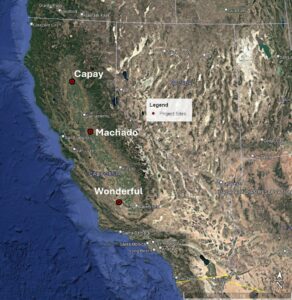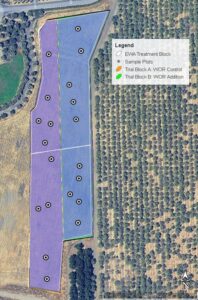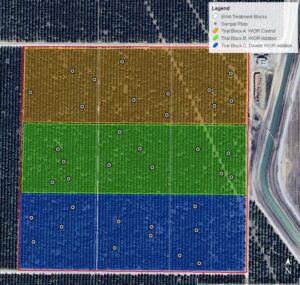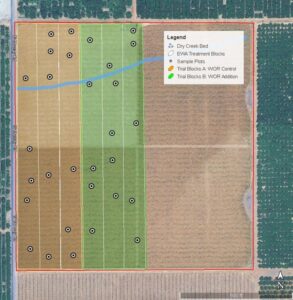Progress report for SW24-013
Project Information
California’s Central Valley represents more than 73% of the US agricultural economy in fruit and nut crops1, due to its uniquely suitable combination of soils, climate and geography. However, this region also suffers from significant air quality issues resulting from the interaction of geographic factors with intensive land use in close proximity to vulnerable communities. This crisis has spurred increased restrictions on agricultural burning. Coupled with ongoing closure of bioenergy infrastructure, this has reduced biomass management options and increased financial strain on many growers, threatening the economic sustainability of California’s perennial cropping industries.
One promising alternative for orchard removal is Whole Orchard
Recycling (WOR), in which biomass is chipped and returned to soil, substantially reducing life cycle pollutant and greenhouse gas (GHG) emissions. However, the cost of WOR implementation is high, and may even exceed burn permit violation fines2, creating a perverse incentive and setting the stage for friction between growers, communities, and regulatory agencies. Although WOR incentive funding exists, opportunities are limited and often unfeasible for smaller farms2,3.
Prior work has demonstrated that WOR has the potential to return up to 2 tons carbon per acre to the soil in organic pools4 – a potential source of carbon credit revenue. However, this represents only a small fraction of the carbon in chipped biomass, with the rest lost during decomposition as CO2. Despite recommendations5 for a major value increase, carbon credits in California today are worth only about $30 per ton6 - insufficient to offset the effort and costs of quantification, verification, and carbon market access let alone incentivize WOR adoption.
In pursuit of state-supported healthy soil goals, some growers are also investigating enhanced weathering amendment (EWA) - an ancient technique using basaltic rock flour as a soil amendment. When exposed to water from irrigation or precipitation, this material absorbs CO2 to create carbonate minerals which enhance soil structure, infiltration, and water holding capacity while storing carbon in long-term inorganic pools7.
This project hypothesizes that a synergistic combination of these practices will increase soil carbon storage and credit revenue potential by enhancing in-soil capture of WOR biomass-derived CO2 before loss to the atmosphere, reducing soil CO2 emission and accumulating carbon in both inorganic and organic pools. Block trials will be conducted in collaboration with participating orchard growers as well as Carbonaught8, a developer of EWA products and associated carbon credit protocols. Soil carbon accumulation under various treatments will be quantified and used to model the potential for access to carbon credit payment revenue streams for growers, based on crop, soils, and spatial relationships with EWA sources.
In collaboration with the California Association of Resource Conservation Districts (CARCD)9, these findings will be used to develop a Best Management Practice guidance document focused on WOR, EWA and most importantly, procedures for grower access to voluntary carbon credit markets. This material will be disseminated to growers through coordination with Resource Conservation District technical advisors10, Farm Bureau and Cooperative Extension representatives, web resources and webinar, and field day events at the trial sites.
Research Objectives
- Quantify soil C in organic and inorganic pools under different WOR and EWA application rates
- Test hypothesis: Combined WOR + EWA results in higher C accumulation than either WOR or EWA alone
- Develop life cycle assessment model to account for transport and application emissions in calculation of net GHG benefits and impacts to ecosystems and communities
- Extrapolate findings to hypothetical statewide adoption in orchard agroecosystems
Educational Objectives
- Develop carbon market access opportunities for growers following ongoing work at UC Davis and by Carbonaught
- Develop BMP guidelines for implementation of EWA alone and in combination with WOR
- Disseminate findings via field day demonstration, cooperative extension, industry conference, webinar, and published materials
Cooperators
- - Producer
- - Producer
- - Producer (Educator)
- (Researcher)
- - Producer
Research
This project was initiated in August, 2024 - delayed due to necessary changes in project design. Specifically, producer Stewart was removed from the project due to lack of geological resources within a cost-effective transport radius, while producer Normoyle pulled out due to closure of the orchard business. These collaborators were replaced with producer Atkins at Capay Farms (Fig. 2) in Orland, CA, and producer Higuera at Wonderful Company (Fig. 3) in Lost Hills, CA. Producer Naraghi remains as a backup site should problems arise at any of the current project sites.




To quantify the synergistic soil organic carbon (SOC) and soil inorganic carbon (SIC) enhancement potential of biomass incorporation via Whole Orchard Recycling (WOR) combined with basalt rock flour addition for enhanced weathering amendment (EWA), it is necessary to establish a baseline SOC for each project site. Given that this project is intended to support carbon market access for growers in California, a soil sampling protocol developed for the carbon credit brokerage Gold Standard was followed. As per this methodology, sample plots were randomly generated in ArcGIS, stratified by USGS SoilWeb map unit intersection with project trial blocks. The number of sample plots was generated to achieve a 20% level of precision based on the reported variability of SOC measurements within each USGS soil map unit present at each site. An equal number of sample plot points were allocated to each trial block.
Each sample plot consists of a central point surrounded by a 0.1 acre circle. Three sub-plot points were designated on this circle, separated by 120 degrees for even spacing, and a fourth sub-plot point at the center. At each point, soil was sampled using an auger, separating topsoil (0-20cm) and subsoil (20-50cm). For each sample plot, the four subsamples were combined to produce separate topsoil and subsoil composite samples. These samples were then assessed for bulk density, and SOC content by pyroanalysis.
Due to the funding freeze in early 2025 and associated staffing interruption, we were unable to apply basalt rock flour as per the project timeline. This delay has led to missing a critical pre-plant window for rock flour application. We had planned to apply the EWA pre-plant, before irrigation systems were installed, to simplify the process. Since planting and irrigation installation have already begun, we have adjusted the plan to accommodate orchard establishment, and EWA will be applied post-planting in the tractor rows. This necessitates a more involved application process, with care taken to prevent infrastructure and tree damage, and will be managed by project partner Carbonaught.
Carbonaught has been responsible for sourcing the EWA materials from geologic resources (quarry and mine byproducts). Although the proper basaltic materials exist in abundance in the Sierra Nevada, active quarry sites capable of providing the correct material quality are limited, and must first be subject to analysis to ensure suitability for application on agricultural land - that is, no significant heavy metal or silica content. Material has been sourced for treatment at Capay and Machado project sites, and is still under assessment for Lost Hills. Once appropriate sources have been located and vetted, their locations will be fed into the geospatial source-sink model to compute transport economic and environmental performance and determine effective ranges for EWA on California cropland. This model is currently under development using ArcGIS, R, and Excel.
Baseline soil organic matter (SOM) levels and intra-site variability have been established according to Gold Standard sampling protocol as described above. SOC will be calculated as a function of SOM following Jensen et al 2018. These data will be used along with site management data from the growers and weather data collected from the California Irrigation Management Information System (CIMIS) to parametrize the DeNitrification-DeComposition soil biogeochemical model to predict soil organic carbon development over the project period and beyond. These predictions will then be validated by additional, ongoing soil sampling and analysis.

Jensen JL, Christensen BT, Schjønning P, Watts CW, Munkholm LJ. Converting loss-on-ignition to organic carbon content in arable topsoil: pitfalls and proposed procedure. Eur J Soil Sci. 2018 Jul;69(4):604-612. doi: 10.1111/ejss.12558. Epub 2018 May 3. PMID: 30174536; PMCID: PMC6109958.
Research Outcomes
No research outcomes are available yet.
Education and Outreach
Participation Summary:
No educational activities have been undertaken as yet, other than initial outreach and consultation with participating producers. Field days will be scheduled following EWA application, and materials produced once calculations on carbon storage potential are complete.
No educational and outreach results are available yet.